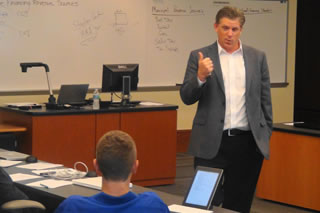News Archive
Orlando Magic exec talks financing with students
Sports teams can be an economic boon to communities -- but often, they need the support of their communities to be able to succeed.

For many sports teams, that support comes in the form of new venues to replace outdated stadiums and arenas. Charles Freeman, chief revenue officer of the Orlando Magic, recently spoke to Professor Michael Mondello's finance class in USF's Sport & Entertainment Management MBA program about funding the Amway Center's $480 million construction from 2008-2010. Now, the arena is widely seen as revitalizing downtown Orlando and the Magic's fan base.
"When we designed the building, we wanted to create an entertainment district," Freeman said. "We can create a destination for people on non-event days that they want to come to, and the events are an added bonus."
Freeman, who is in his 17th season with the Magic and was recently selected to the SportsBusiness Journal's Forty Under 40, supervised the arena's construction and its fundraising -- a process that was a combination of private funding from the DeVos family ownership, bonds, and public land and tax dollars. The City of Orlando owns the Amway Center, eliminating the need for the Magic to pay property taxes or manage the venue, but the Magic had full control over the building process.
Freeman said the process of getting the stadium built was "like a crash-course MBA."
"I was very, very lucky to be able to do the Amway center. I can't even change a light bulb in my house," Freeman joked.
One of the most difficult -- but essential -- elements of the process was getting a sixth cent added on to the already existing five cent Tourist Development Tax, which is charged on all overnight stays to the area. With all the attractions in Orlando, the tourist tax was a steady and dependable stream of income that could easily be bonded and provide the money needed for the arena's construction.
But, Freeman noted, the process was not without its political landmines. The Magic had to convince the tourism industry that the new arena would benefit hotels and attractions. However, the arena wasn't likely to bring in the out-of-state visitors that those hotels and attractions depended on.
The compromise: Arena construction took only half a penny of the tax, and the other half a cent went to promote tourism. With that half a cent, the Magic was able to obtain $270 million in financing.
"It was about tying this together for a better place to live, work, and play," Freeman said.
The Amway Center was one of the last stadiums to receive such a large public cash subsidy, Freeman noted. Because of the strain on public budgets in recent years, he thinks that lack of public financing is likely to continue.
"I think we will be the last for a while," Freeman said. "I think what you're going to see is a wave of arena renovations versus new arenas."
Freeman advised the Sport & Entertainment Management students to go into their internships and jobs and look at where they could add value. He told them to ask themselves what they could do that drives new things and creates innovation.
"I've got a young core team, and they're not afraid to explore and research," he said.